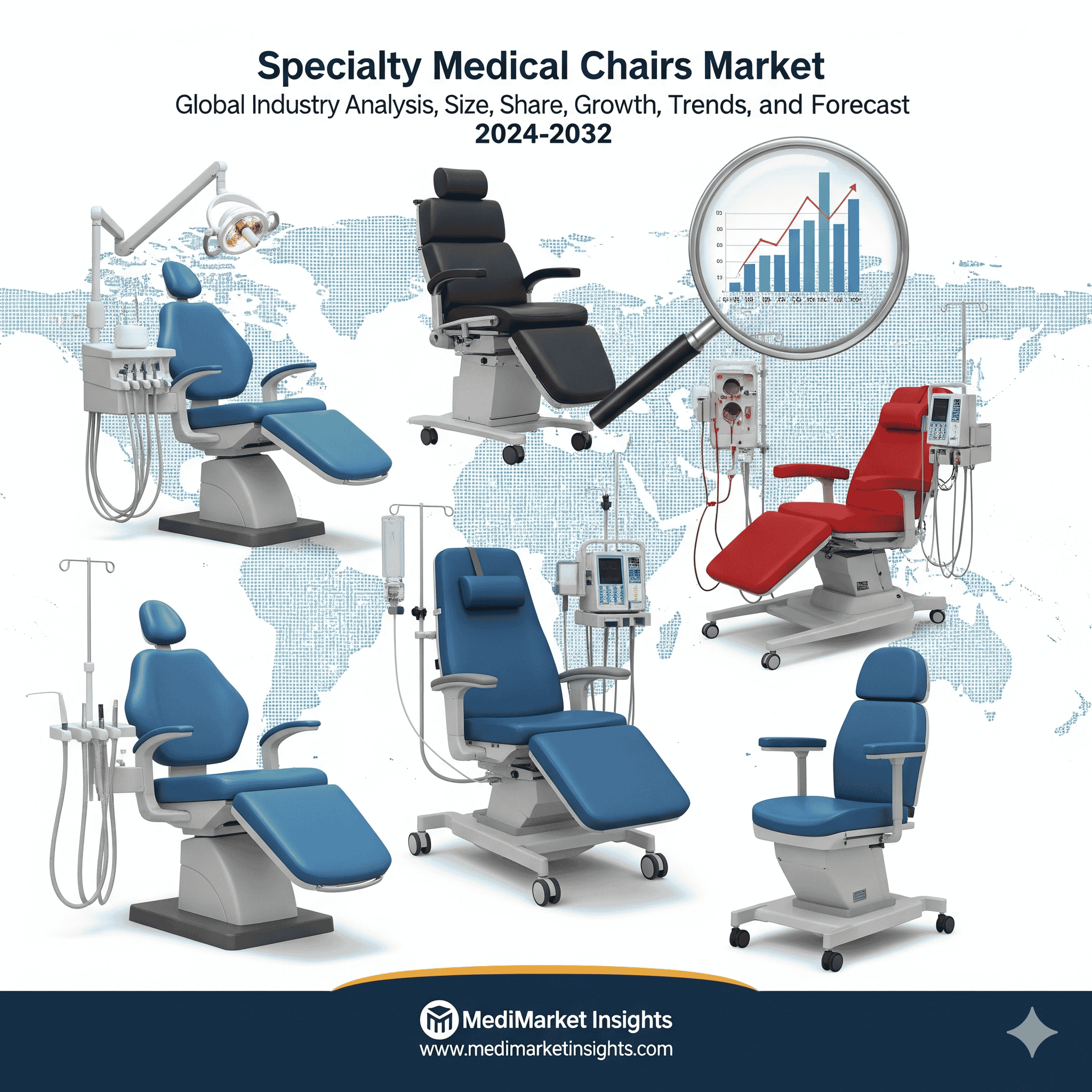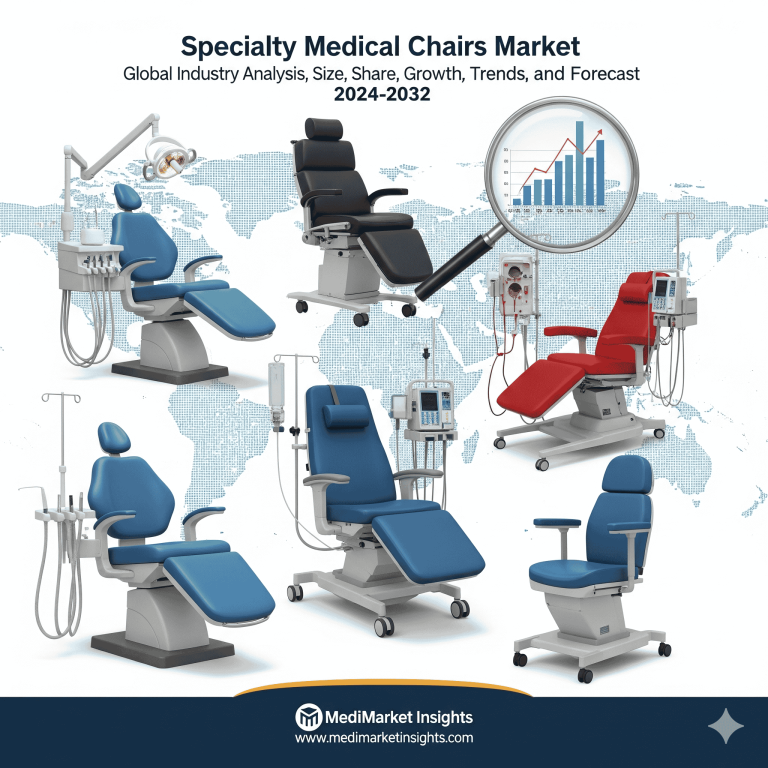
The global specialty medical chairs market is valued at USD 5.12 billion in 2025 and projected to reach USD 9.77 billion by 2034, growing at a CAGR of 7.43% (2025–2034). North America leads with 43% share in 2024, while Asia-Pacific is the fastest-growing region, driven by rising elderly population, chronic diseases, and healthcare infrastructure investments.
Download the free sample and get the complete insights and forecasts report on this market @ https://www.towardshealthcare.com/download-sample/5480
Market-size
Historical / baseline numbers (anchor points)
◉2024 market size (reported): USD 4.77 billion.
◉2025 market size (reported): USD 5.12 billion.
Forecast headline
◉2034 projected market size: USD 9.77 billion; CAGR 2025–2034 = 7.43%.
Yearly totals reconstructed from product breakdown (consistency check)
◉Calculated totals from the provided product-series (Examination + Rehabilitation + Treatment chairs) produce:
2024 4.77B, 2025 5.12B, 2026 5.50B, 2027 5.91B, 2028 6.36B, 2029 6.83B, 2030 7.34B, 2031 7.88B, 2032 8.47B, 2033 9.09B, 2034 9.76B.
◉Note: the derived 2034 total (9.76B) differs by 0.01B from the stated 9.77B — this is attributable to rounding in sub-segment figures; both numbers are consistent within rounding precision.
Growth pattern interpretation
◉The market exhibits a steady, mid-single-digit to low-double-digit expansion year-on-year. Growth accelerates in absolute dollars after 2029 (the total increases by larger absolute amounts as the base grows).
◉The rehabilitation chairs subseries is the largest contributor to total value and thus the main engine of absolute market expansion.
Value drivers behind the monetary growth
◉Demographic expansion (global ageing), higher prevalence of chronic disease, increased outpatient and rehabilitation care, faster uptake of premium/automated chairs and hospital capital spending (explicitly cited increases in government health capital spending).
Market trends
Demographic and clinical demand trends
◉Ageing population: WHO/statistics cited—60+ population rising sharply (from 900M in 2015 to ~2B by 2050) — increases demand for geriatric and long-term care seating.
◉Chronic disease prevalence: More patients with diabetes, cardiovascular disease, cancer and musculoskeletal disorders require recurrent procedures and rehabilitative seating.
Product evolution and technology adoption
◉Advanced/automated chairs: Increasing introduction of motorized adjustment, pressure-relief designs and digitally integrated delivery systems (example: A-dec 500 Pro / 300 Pro).
◉Digitally integrated dental & surgical chairs: suppliers adding digital workflows and integrated delivery units — trend toward software + chair bundles.
Service-setting shifts
◉Hospitals remain largest end-use (2024) due to acute care, surgeries and post-surgical rehabilitation needs.
◉Clinics/outpatient growth: Faster % growth forecast for clinics driven by outpatient surgery growth, specialized clinics (dental, ophthalmic, physiotherapy) and cost-efficient care models.
◉Regional investment & policy trends
◉Increased government capital spending (examples: India Union Budget 2025–26; UK health capital increase; Newfoundland & Labrador investments) — supports procurement of advanced chairs.
◉International aid/aid logistics example: RNZAF delivering specialized chairs to Samoa (shows philanthropic/aid channel demand).
M&A, distribution and investment activity
◉Strategic acquisitions and investments (Nakanishi → DCI; Foresight → DP Medical Systems; Infinium Medical + Lemi MD distribution) reflect consolidation and distribution expansion to capture regional demand.
Price / affordability pressure
◉High cost of premium chairs (cited EUR 4,000–8,000 for some intensive-care chairs) restrains adoption in price-sensitive markets and pushes demand for lower-cost alternatives or refurbished units.
Adjacency and substitution
◉Competition from stretchers, standard exam chairs and electric wheelchairs — rising acceptance of electric mobility devices is both an opportunity and a substitute threat depending on application.
Role & impact of AI / ML
Patient-centric real-time positioning
◉AI-driven controllers can ingest sensor streams (pressure maps, patient posture, vitals) to automatically adjust chair angle, back/leg support and headrests to prevent pressure ulcers, optimize surgical access angles, and maximize comfort without manual intervention.
Personalization & patient profiling
◉ML models trained on patient anthropometrics, clinical condition, and prior preference histories can create personalized seat-profiles (auto recall for recurring patients) — improving throughput and reducing setup time.
Predictive maintenance & uptime optimization
◉Telemetry + ML anomaly detection predicts motor, actuator, or electronics failures before breakdown; schedules preventive maintenance, reducing downtime for high-utilization hospital chairs and lowering total cost of ownership.
Surgery-grade precision positioning
◉For chairs/tables used in procedures (ophthalmic, dental, ambulatory surgery), AI can provide micro-adjustments aligned to surgical robot movements or imaging guidance — enhancing ergonomic access and reducing procedure time.
Manufacturing & supply-chain improvements
◉AI optimizes production scheduling, demand forecasting, and parts sourcing (reducing lead times); generative design can suggest lighter/stronger structural components for chairs at lower material cost.
Clinical decision support integration
◉Chairs that communicate with EHRs/monitoring systems can adjust based on patient vitals (for example: raise head at signs of respiratory distress), and report usage metrics back to clinical teams.
Adaptive user interfaces & accessibility
◉Voice-enabled, ML-driven UIs and simplified control flows help staff (and patients with disabilities) operate complex chairs safely with minimal training.
Regulatory and safety validation
◉AI systems will require clinical validation; explainable ML and traceable logs will be needed to satisfy procurement and regulatory scrutiny — a short-term barrier but long-term differentiator for compliant vendors.
Market implications
◉Premiumization: AI features command price premiums, shifting average selling prices upward (supports higher market value).
◉New revenue streams: Predictive maintenance subscriptions, software licenses, and analytics-as-a-service create recurring revenue beyond hardware sales.
Regional insights

North America (dominant: 43% share in 2024)
Drivers
◉Large elderly population increase (U.S. 65+ projected +47% by 2050 from PRB data), robust reimbursement frameworks, high hospital budgets.
Capabilities
◉Strong presence of major OEMs, dense installed base of high-end chairs, rapid uptake of AI/automation features.
Challenges
◉High labor and purchase costs; procurement focus on ROI and regulatory compliance.
Implication
◉Market leader by value; largest share of premium/advanced chairs and software services.
Europe
Drivers
◉Mature healthcare systems, strong outpatient procedural volumes, emphasis on patient safety and comfort.
Capabilities
◉High adoption of advanced technologies; public procurement programs fund modernization.
Variation
◉Northern/Western Europe faster to adopt premium models; some Eastern markets more price sensitive.
Implication
◉Stable high-value market with regulatory scrutiny and strong demand for durable, certified equipment.
Asia-Pacific (fastest growth predicted)
Drivers
◉Rapid population growth, rising healthcare expenditure, growing middle class, increasing surgical volumes and road-traffic injuries.
Capabilities
◉Rapid hospital expansion and home-care services; mixed maturity — China and India are key growth engines.
Challenges
◉Price sensitivity in many markets forces OEMs to offer tiered products or localization strategies.
Implication
◉High absolute volume growth opportunity; demand for mid-to-high tier chairs and localized manufacturing/distribution.
Latin America
Drivers
◉Growing geriatric cohort, increasing medical tourism, rising healthcare spend in large markets (Brazil, Mexico).
Constraints
◉Budget constraints and uneven distribution of advanced care; reliance on multinational suppliers for premium units.
Implication
◉Growing replacement and new-installation market; potential for used/refurbished equipment trade.
Middle East & Africa
Drivers
◉Selective government investment in large hospital projects; Gulf states as premium buyers.
Constraints
◉Many countries are price sensitive with fragmented procurement; logistics and maintenance networks can be weak.
Implication
◉Patchwork market—niche premium demand (GCC) and slower growth elsewhere.
Market dynamics
Drivers (detailed)
◉Ageing population: Larger 60+ and 80+ cohorts increase long-term care and procedural volumes; WHO projections cited (60+ doubling toward ~2.1B by 2050).
◉Rising chronic disease burden: More dialysis, oncology, cardiology, and rehabilitation cases → higher seat/therapy chair demand. (U.S. example: ~129M people with at least one chronic condition.)
◉Technology premiumization: Adoption of automated/digital chairs with AI/ML, pressure-management and integrated delivery systems increases both unit value and replacement cycles.
◉Government capital spending: Documented increases in public capital (India budget, UK New Hospital Programme, regional investments) fuel procurement.
Restraints (detailed)
◉High unit cost of premium chairs: High-end models (EUR 4k–8k) limit adoption in low-income settings.
◉Maintenance & total cost of ownership: Ongoing service contracts and part replacement costs deter some buyers.
◉Awareness & training: Clinical staff unfamiliarity with advanced features reduces utilization and perceived value.
Opportunities (detailed)
◉Electric mobility convergence: Growing acceptance of electric wheelchairs and IoT sensors creates cross-sell and platform opportunities (Invacare example).
◉Home healthcare expansion: Demand for comfortable, safe chairs for home infusion, dialysis, and long-term care.
◉Software & service revenue: Predictive maintenance, remote monitoring, and analytics subscriptions as recurring revenue.
◉Emerging-market penetration: Tiered products and localized manufacturing to capture APAC and LATAM growth.
Top companies

A-dec, Inc.
◉Product focus: Dental chairs and digitally integrated delivery systems (A-dec 500 Pro / 300 Pro).
◉Overview: Established dental equipment OEM with product lines integrating ergonomic chairs and delivery units.
◉Strengths: Strong dental market brand, integrated digital workflows, North American distribution and service footprint.
ActiveAid, Inc.
◉Product focus: Specialized seating and pressure-relief chairs (rehab focus).
◉Overview: Rehab seating specialist targeting geriatrics and bariatric segments.
◉Strengths: Niche rehab expertise and product customization.
DentalEZ, Inc.
◉Product focus: Dental chairs and dental delivery systems.
◉Overview: Longstanding dental equipment vendor.
◉Strengths: Product reliability for dental clinics; broad clinic channel penetration.
Fresenius Medical Care AG & Co. KGaA
◉Product focus: Dialysis chairs and systems.
◉Overview: Global leader in dialysis solutions; chairs form part of integrated offering for dialysis centers.
◉Strengths: Deep clinical domain knowledge in dialysis, global service network, strong purchasing relationships with dialysis centers.
Topcon Corp.
◉Product focus: Ophthalmic chairs and ophthalmic equipment integration.
◉Overview: Optical/ophthalmic systems vendor offering chairs as part of wider ophthalmic suites.
◉Strengths: Clinic workflow integration, ophthalmology domain expertise.
Midmark Corp.
◉Product focus: Examination chairs, surgical chairs, treatment seating and medical-furniture solutions.
◉Overview: Broad clinical furniture and equipment OEM with manufacturing and educational outreach (e.g., WCOMP partnership).
◉Strengths: Strong OEM reputation, cross-product bundles for clinics/hospitals, emphasis on local partnerships.
Danaher (KaVo Dental GmbH)
◉Product focus: Dental chairs and instruments (KaVo brand).
◉Overview: Large diversified medical technology conglomerate; KaVo an established dental brand within Danaher.
◉Strengths: R&D resources, distribution scale, strong dental brand equity.
Dentsply Sirona
◉Product focus: Dental chairs and integrated dental solutions.
◉Overview: Global dental OEM with comprehensive product portfolio.
◉Strengths: Market reach in dental clinics, innovation in dental equipment.
Planmeca Oy
◉Product focus: Dental and imaging integrated chairs.
◉Overview: Finland-based dental equipment innovator with imaging and chair combos.
◉Strengths: Integrated imaging + chair solutions, strong European presence.
Hill Laboratories Company (and similar regional players)
◉Product focus: Hospital beds and specialty seating (varies by company).
◉Overview: Industrial / medical furniture manufacturers serving hospitals.
◉Strengths: Hospital procurement relationships, capability to supply large projects.
Rahab Seating Systems Inc.
◉Product focus: Rehabilitation and specialty seating for bariatric/pediatric/geriatric users.
◉Overview: Specialty seating OEM for rehab markets.
◉Strengths: Niche product engineering and customization.
Latest announcements
Vivid.Care — HiBack Bedside Chair (Feb 2025)
◉What: Launch of the HiBack Bedside Chair addressing height adjustability, pressure care and patient ergonomics.
◉Why it matters: Responds directly to ward-level issues (pressure sores and poor ergonomics) reported by ward managers and tissue-viability nurses; positions Vivid.Care in acute ward seating market with a product designed for staff handling and patient discharge improvement.
◉Implication: If widely adopted, improves patient throughput and reduces pressure-injury related costs; demonstrates product development driven by frontline clinician feedback.
Infinium Medical + Lemi MD distribution (Mar 4, 2025)
◉What: Exclusive U.S. distribution agreement for Lemi MD-Series surgical chairs (Dreamed Procedure Chair, Monza Mobile Surgery Chair, Lemi 4 Procedure Table).
◉Why it matters: Expands the Lemi MD footprint into the U.S., increasing availability of procedure-specific chairs optimized for ambulatory and mobile surgery.
◉Implication: Strengthens distribution channels and may accelerate sales in outpatient procedural settings.
Recent developments
RNZAF delivery to Samoa (Mar 2025)
◉Details: Five specialized chairs for chemo/dialysis delivered via RMZAF C-130J donated by Christchurch’s Forté Health Hospital.
◉Significance: Highlights role of donor/aid logistics in distributing bulky, high-value chairs to remote/rural care sites; showcases chairs’ criticality for continuity of chronic care in island nations.
Vivid.Care HiBack launch (Feb 2025) — see “Latest announcements” for full depth.
◉Foresight investment in DP Medical Systems (£4.45M, Aug 2024)
◉Details: Investment targeted at product launches and scaling distribution.
◉Significance: Example of private capital fueling distributor growth and broader market reach for specialty chairs and consumables.
Nakanishi Inc. acquisition of DCI International (Aug 2023)
◉Details: Acquisition to strengthen U.S. dental chair/instrument sales.
◉Significance: M&A to consolidate dental chair portfolio and accelerate access to U.S. dental market.
A-dec product introductions (Jun 2023)
◉Details: A-dec 500 Pro and 300 Pro digitally integrated dental delivery systems launched in North America.
◉Significance: Illustrates the trend toward digital integration in dental chairs and added value through software/equipment bundles.
Midmark + WCOMP / Ohio STEM (Mar 4, 2024)
◉Details: Partnership to promote manufacturing careers and innovation.
◉Significance: OEMs investing in talent pipelines to support future product development and local manufacturing.
Segments covered
By Product — explanations & subpoints
Examination Chairs
◉Subtypes: General exam chairs, cardiology exam chairs, mammography supports, multipurpose clinic chairs.
◉Role: First-contact seating for diagnostics and routine exams; high unit volumes in clinics and small hospitals.
◉Value driver: Lower per-unit price but high replacement cadence in outpatient settings.
Rehabilitation Chairs (dominant segment in 2024)
◉Subtypes: Pediatric chairs, bariatric chairs, geriatric chairs, positioning/bathing chairs.
◉Role: Long-use seating in rehab centers and long-term care; focuses on pressure management, positioning and mobility support.
◉Why dominant: Large elderly and chronic care populations requiring rehab; higher price points for specialized features.
Treatment Chairs
◉Subtypes: Ophthalmic chairs, ENT chairs, dental chairs, procedure/treatment chairs.
◉Role: Procedure-specific chairs that enable clinicians’ access and integrate with instruments/diagnostics.
◉Growth driver: Increasing outpatient procedural volumes and the push for clinic-based surgeries.
By End-use — explanations
Hospitals
◉Why largest share (2024): Hospitals handle acute cases, surgeries, and in-patient rehab where high-spec chairs are essential.
Clinics
◉Why fast growth: Outpatient surgery, dentistry, ophthalmology, and physiotherapy growth fuels clinic purchases.
Others
◉Includes: Home care, long-term care facilities, mobile clinics, aid deployments.
By Region — explanations
Top 5 FAQs
-
Q: What is the current size and projected growth of the specialty medical chairs market?
A: The market was USD 4.77B in 2024, USD 5.12B in 2025, and is projected to reach ~USD 9.77B by 2034, growing at a 7.43% CAGR (2025–2034). -
Q: Which product segment contributed the most value in 2024 and why?
A: Rehabilitation chairs dominated in 2024 (largest sub-segment) due to rising elderly populations, increased spinal/neurological injuries, and demand for specialized positioning (pediatric, bariatric, geriatric). -
Q: Which region leads the market and which region is fastest-growing?
A: North America led with about 43% market share in 2024, driven by ageing demographics and reimbursement frameworks. Asia-Pacific is predicted to have the fastest growth over the forecast period due to large population growth, rising healthcare spend, and expanding surgical volumes. -
Q: What restrains adoption of specialty medical chairs?
A: Key restraints include high unit cost (premium chairs often EUR 4k–8k), ongoing maintenance costs, limited awareness/training, and competition from substitutes (stretchers, standard exam chairs, or electric wheelchairs). -
Q: How will AI change the specialty medical chairs market?
A: AI/ML will enable automatic personalized positioning, predictive maintenance, surgery-grade micro-adjustments, and new software/service revenue streams — driving premiumization, higher ASPs, and recurring revenue models (licenses, maintenance subscriptions).
Access our exclusive, data-rich dashboard dedicated to the healthcare market – built specifically for decision-makers, strategists, and industry leaders. The dashboard features comprehensive statistical data, segment-wise market breakdowns, regional performance shares, detailed company profiles, annual updates, and much more. From market sizing to competitive intelligence, this powerful tool is one-stop solution to your gateway.
Access the Dashboard: https://www.towardshealthcare.com/access-dashboard
Immediate Delivery Available | Buy This Premium Research @ https://www.towardshealthcare.com/price/5480
Become a valued research partner with us – https://www.towardshealthcare.com/schedule-meeting
You can place an order or ask any questions, please feel free to contact us at sales@towardshealthcare.com
Powering Healthcare Leaders with Real-Time Insights: https://www.towardshealthcare.com/healthcare-intelligence-platform
Europe Region – +44 778 256 0738
North America Region – +1 8044 4193 44
Web: https://www.towardshealthcare.com
Find us on social platforms: LinkedIn | Twitter | Instagram | Medium | Pinterest





